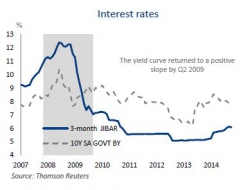KZN Provincial Treasury - KZN Economy2014-11-13 Some relevant articles relevant to the KZN Economy. It also includes the first attempt to develop a monthly KZN GDP variable.
KWA-ZULU-NATAL GROSS DOMESTIC PRODUCT TEMPORAL DISAGGREGATION WITH A FUEL CONSUMPTION INDICATOR1 KZN Application This study is an application of model-based approaches to the GDP quarterly data (high frequency) of the province, using a related indicator namely fuel (diesel and petrol) consumption (low frequency) for the period 2008 to 2013. The ECOTRIM software for temporal disaggregation is used to perform the analysis. ECOTRIM is a computer based programme developed by Eurostat specifically for temporal disaggregation of time series. KZN quarterly real GDP for the period is displayed the below graph. A very clear seasonal pattern in the time series is noticeable. KZN monthly fuel consumption (litres) is displayed in graph 2. Coetzee (2012) argues that it is therefore (results of an error correction model) possible to conclude that there indeed exists a short and long run statistically significant relationship between national GDP and national fuel consumption. Fuel consumption can therefore be used as a proxy for GDP. Click below link to download Working Paper 2b: 10 November 2014: KZN GDP Temporal Disagregation.pdf - 0.3 Mb BER Economic Snapshot Highlights IMF cuts SA’s growth forecast The IMF cut its economic growth outlook for South Africa to 1.4% for 2014 and 2.3% for 2015. The current projection for 2014 represents a 1.5 percentage point cut to the IMF’s October 2013 forecast of 2.9%. The IMF cited the difficult industrial relations environment and infrastructure backlogs (specifically electricity constraints) as the main reasons for the downward adjustment. The IMF’s growth forecast for 2014 is now in line with the BER’s expectation for this year. However, at a projected 2.9% the BER remains more optimistic about next year, albeit that risks are clearly on the downside and growth could be closer to the IMF’s 2.3%. MTBPS stresses short-term pain for long-term fiscal sustainability Newly appointed Finance Minister, Nhlanhla Nene, delivered his first Medium Term Budget Policy Statement (MTBPS). The minister faced a difficult task â€" he had to deal with a significantly weaker macroeconomic backdrop than was projected at the time of the February Budget, while at the same time reassuring rating agencies and financial markets. In the event, the minister certainly rose to the occasion; not only did he base his fiscal analysis on reasonably conservative growth projections, but he was also prepared to lower the government’s expenditure ceiling and to signal tax increases next year. For a full analysis, please see the latest BER Comment. September CPI inflation surprises on the downside Consumer price inflation remained flat in September. As a result, the annual rate slowed to 5.9% year-on-year, from 6.4% in August. While markets were expecting a moderation in consumer inflation, the actual figure came in lower than the 6.1% predicted. This is the first time since February that headline inflation fell within the South African Reserve Bank’s target range of 3 â€" 6%. The downside surprise stemmed mainly from lower-than-expected food price inflation. Food prices rose by 0.1% over the month (from a 0.7% increase in August), resulting in the annual rate falling from 9.5% in August to 8.7% in September. Additional downward pressure emanated from the transport category. A 4.8% month-on-month drop in the price of petrol resulted in annual transport inflation moderating from 6.1% to 4.2%, which shaved 0.3 percentage points off the headline number. Click below link to download economic snapshot: BER Snapshot 2014-11.pdf - 0.6 Mb KwaZulu-Natal Business Barometer September 2014 KwaZulu-Natal's economy is under strain due to a lack of growth in the two biggest sectors, manufacturing and finance, showing that the economic slump is still broad-based. The latest KwaZulu-Natal barometer, as compiled by Mike Schüssler of Economists.co.za, declined 2.4% year-on-year, the most in 13 months, as increased economic stress eroded the effect of the little growth the economy has shown. Click below link to download KZN Barometer for Sep 2014: KwaZulu-Natal Business Barometer Sep 2014.docx - 0.3 Mb BER Inflation Expectations Q3 Inflation expectations The average inflation expectations of analysts, business people and trade union officials for the current and next two years remained unchanged compared to the previous survey. This is the seventh consecutive quarter in which average inflation expectations remained largely unchanged. Whereas analysts expect inflation to decelerate from 6.2% in 2014 to 5.4% in 2016, business people expect it to accelerate to 6.4%. In contrast, trade union officials foresee inflation to remain flat at 6.2% over the whole period. Average inflation expectations over the next five years declined from 6.1% to 5.9%, as trade union officials reversed their forecast to 5.9%. However, one should not attach too much weight to the results of the trade unions of a single quarter, as their expectations have fluctuated quite a bit between consecutive quarters over the three years that five year expectations have been surveyed. Click below link to download Inflation Survey Q3: BER Inflation Exp 14Q3.pdf - 0.4 Mb Dr Clive Coetzee General Manager: Infrastructure Management and Economic Services KZN Provincial Treasury Economist (PhD UKZN) 033 897 4538 http://www.kzntreasury.gov.za |
KZN Provincial Treasury - KZN Economy
Copyright © 2024 KwaZulu-Natal Top Business
